Are you a vocalist who feels held back by wired microphones? Why not try a wireless microphone?
There are many benefits to investing in a wireless handheld microphone system. And with systems suited to every level, why hold back? The time to go wireless is now!
What are the main benefits of wireless microphones?
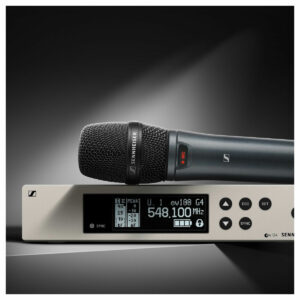 If you use a handheld microphone, you’ll have experienced a time when its cable got in the way.
If you use a handheld microphone, you’ll have experienced a time when its cable got in the way.
It might have gotten tangled around a body part. Or not been long enough when you were getting closer to the audience. Or even unplugged at an inopportune moment.
Well, with wireless handheld microphone systems – these issues are a thing of the past.
You’ll have nothing to get tangled in as there are no cables.
You can get as close to the audience as you want, unrestricted.
And you don’t have to worry about cables becoming unplugged or faulty.
To put it simply: wireless handheld mics give you freedom.
What do I get with a wireless handheld microphone system?
For those new to wireless audio, getting a wireless handheld mic system might seem daunting at first. But is it? I’d like to think it’s not, and here’s why:
Every wireless microphone system comes with a transmitter and a receiver unit. The transmitter sends audio captured by the microphone capsule to the receiver, which is then plugged into a mixing desk or some other kind of audio interface.
For most wireless handheld systems, the mic capsule and the transmitter are an integrated unit. However, you can get plug-in XLR transmitters too, which work with any regular dynamic mic.
To set up the system, you need to set the transmitter and receiver to the same frequency. Support for automatic pairing on most devices means even this step can be a breeze.
What should I look for in a wireless handheld microphone system?
 Although wireless systems are pretty easy to use, the extensive features list can make it difficult to choose one.
Although wireless systems are pretty easy to use, the extensive features list can make it difficult to choose one.
So, what should you look for in a wireless microphone for singers?
Battery life
Want to sing for hours and hours? You’ll need to make sure your wireless microphone’s battery lasts long enough.
Most wireless systems for vocalists have time for a whole performance, but you don’t want to be caught out. So make sure to check the battery life is high enough for your personal requirements.
Wireless frequency range
Most wireless systems will come with different wireless frequency ranges available for the same model. These are designed for use in different countries, with some frequencies requiring licences in some countries, while not requiring any in others.
All our listings include a map that shows the license requirements for each system. This way, you’ll never be caught off guard.
As a side note, digital systems are usually license-free in all countries.
Operating range
How far will you need to go with your mic? There can be significant range differences between systems, so you should examine this part of the specs.
While wireless mics let you go further than cables without worry, they do have there limit. Thankfully, the operating range can be pretty high, especially with premium models.
Signal-to-noise-ratio
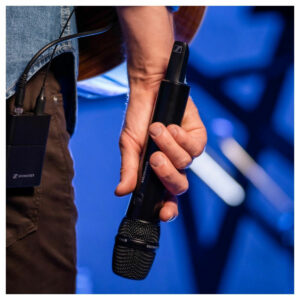 When using wireless, there’ll always be some level of interference from other devices. Luckily, most systems have a good signal-to-noise ratio, so you won’t hear any of this interference.
When using wireless, there’ll always be some level of interference from other devices. Luckily, most systems have a good signal-to-noise ratio, so you won’t hear any of this interference.
But some devices do have better signal-to-noise ratios than others. So this is worth checking if you want to get the best sound possible.
Scalability
You might want one wireless mic for now, but will you want to add extra systems down the line?
If the answer is yes, you should check how many systems your chosen model supports on a single network. You wouldn’t want to go for a cheaper model just to have to fully replace it when you need to add more systems.
But what about my favourite microphone?
Without your favourite microphone, you might have reservations about going wireless. But what if I told you that you can still use it?
With a wireless XLR system, such as the Sennheiser XSW-D XLR Base Set, you can plug in a battery-powered XLR transmitter to any dynamic microphone. This allows you to take mics that you already own and turn them wireless in a few short moments.
Lots of big name manufacturers also make wireless versions of their flagship mics. For example, Shure make a wireless version of the iconic SM58 that you can get with the Shure BLX24/SM58-K3E Handheld Wireless Microphone System.
So – to cut a long story short – you don’t have to give up your favourite mic to go wireless!
Product recommendations
What system should you go for? Let me take you through a few…
SubZero SZW-20 Handheld Wireless Microphone System
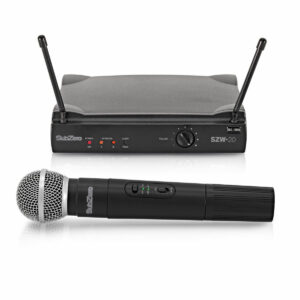 The SubZero SZW-20 Handheld Wireless Microphone System is a great entry-level option if you are just starting with wireless microphones.
The SubZero SZW-20 Handheld Wireless Microphone System is a great entry-level option if you are just starting with wireless microphones.
It’s made to be easy – just plug it into your PA, switch it on, and get singing.
The included microphone transmitter also has onboard power and mute controls, giving you or any vocalist excellent control onstage.
It has a 3 – 4.5-hour battery life too – perfect for any show.
Shop now | SubZero SZW-20 Handheld Wireless Microphone System
Sennheiser XSW 1-825 Vocal Set
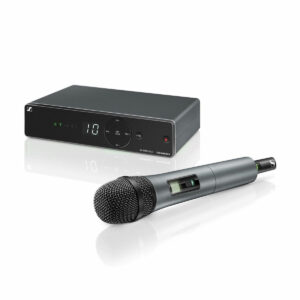 This vocal set from Sennheiser is a bit of a step up from the previous mic.
This vocal set from Sennheiser is a bit of a step up from the previous mic.
Its transmitter uses Sennheiser’s renowned 825 capsule, so you’re guaranteed to sound great.
Plus, it features automatic frequency management and simple component synchronisation, which keeps setup simple.
And you can use ten systems at a time – so it’s pretty scalable!
Shop now | Sennheiser XSW 1-825 Vocal Set
Shure BLX24/SM58-K3E Handheld Wireless Microphone System
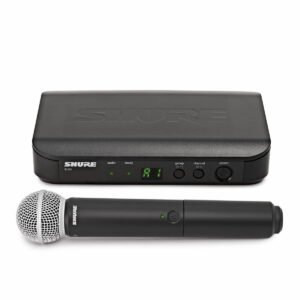 The Shure BLX24/SM58-K3E Handheld Wireless Microphone System uses Shure’s classic SM58 capsule in a user friendly package.
The Shure BLX24/SM58-K3E Handheld Wireless Microphone System uses Shure’s classic SM58 capsule in a user friendly package.
It has an impressive 14-hour runtime and can support up to 12 compatible systems simultaneously.
Plus, one touch Quickscan delivers effective setup for a consistently clear and uninterrupted signal.
Shop now | Shure BLX24/SM58-K3E Handheld Wireless Microphone System
Shure BLX288/PG58-K3E Dual Handheld Wireless Microphone System
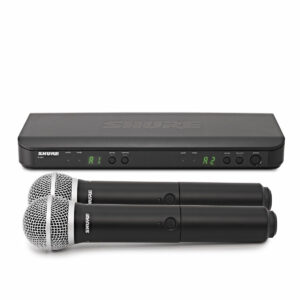 Another great Shure option is the Shure BLX288/PG58-K3E Dual Handheld Wireless Microphone System.
Another great Shure option is the Shure BLX288/PG58-K3E Dual Handheld Wireless Microphone System.
This is a dual system, so it comes with two transmitters, as well as a dual receiver that can receive signals from both.
Each transmitter also has the Shure PG58 capsule for a classic live sound.
Shop now | Shure BLX288/PG58-K3E Dual Handheld Wireless Microphone System
Sennheiser EW-D 835-S Wireless Handheld Set
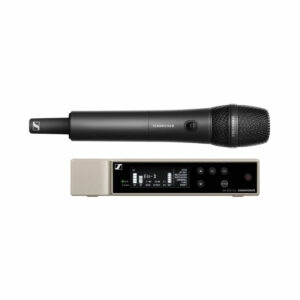 For something a bit more upmarket, go for the Sennheiser EW-D 835-S Wireless Handheld Set.
For something a bit more upmarket, go for the Sennheiser EW-D 835-S Wireless Handheld Set.
It has a handy Android/iOS app that makes operation and setup easier for you to manage.
The set also boasts a massive range of over 300ft as well as scalability up to a whopping 90 channels!
Shop now | Sennheiser EW-D 835-S Wireless Handheld Set
Sennheiser XSW-D XLR Base Set/SubZero Wireless XLR Microphone System
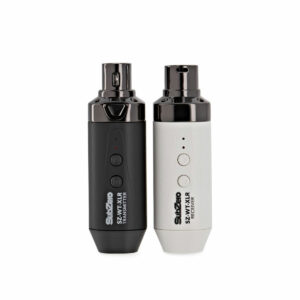 As already mentioned, the Sennheiser XSW-D XLR Base Set is a great option for converting wired mics into wireless systems.
As already mentioned, the Sennheiser XSW-D XLR Base Set is a great option for converting wired mics into wireless systems.
But if you want something on the cheaper side, the SubZero Wireless XLR Microphone System is another good option.
Shop now | Sennheiser XSW-D XLR Base Set
Shop now | SubZero Wireless XLR Microphone System
More resources
Hopefully this guide has given you a better idea of wireless microphones for vocalists.
Want to find out more? Check out our guide to Sennheiser wireless systems. Or check out our guide to live sound.
Want to hear what you sing? Have a look at our guide to IEMs for 2022.

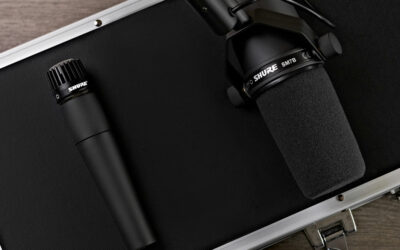
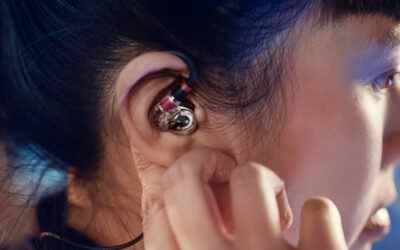
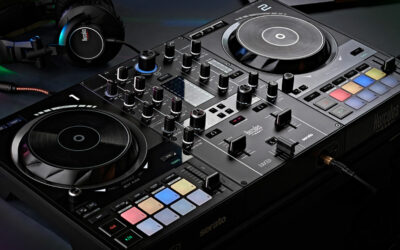

0 Comments